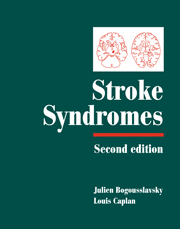Book contents
- Frontmatter
- Contents
- List of contributors
- Preface
- PART I CLINICAL MANIFESTATIONS
- 1 Stroke onset and courses
- 2 Clinical types of transient ischemic attacks
- 3 Hemiparesis and other types of motor weakness
- 4 Sensory abnormality
- 5 Cerebellar ataxia
- 6 Headache: stroke symptoms and signs
- 7 Eye movement abnormalities
- 8 Cerebral visual dysfunction
- 9 Visual symptoms (eye)
- 10 Vestibular syndromes and vertigo
- 11 Auditory disorders in stroke
- 12 Abnormal movements
- 13 Seizures and stroke
- 14 Disturbances of consciousness and sleep–wake functions
- 15 Aphasia and stroke
- 16 Agitation and delirium
- 17 Frontal lobe stroke syndromes
- 18 Memory loss
- 19 Neurobehavioural aspects of deep hemisphere stroke
- 20 Right hemisphere syndromes
- 21 Poststroke dementia
- 22 Disorders of mood behaviour
- 23 Agnosias, apraxias and callosal disconnection syndromes
- 24 Muscle, peripheral nerve and autonomic changes
- 25 Dysarthria
- 26 Dysphagia and aspiration syndromes
- 27 Respiratory dysfunction
- 28 Clinical aspects and correlates of stroke recovery
- PART II VASCULAR TOPOGRAPHIC SYNDROMES
- Index
- Plate section
12 - Abnormal movements
from PART I - CLINICAL MANIFESTATIONS
Published online by Cambridge University Press: 17 May 2010
- Frontmatter
- Contents
- List of contributors
- Preface
- PART I CLINICAL MANIFESTATIONS
- 1 Stroke onset and courses
- 2 Clinical types of transient ischemic attacks
- 3 Hemiparesis and other types of motor weakness
- 4 Sensory abnormality
- 5 Cerebellar ataxia
- 6 Headache: stroke symptoms and signs
- 7 Eye movement abnormalities
- 8 Cerebral visual dysfunction
- 9 Visual symptoms (eye)
- 10 Vestibular syndromes and vertigo
- 11 Auditory disorders in stroke
- 12 Abnormal movements
- 13 Seizures and stroke
- 14 Disturbances of consciousness and sleep–wake functions
- 15 Aphasia and stroke
- 16 Agitation and delirium
- 17 Frontal lobe stroke syndromes
- 18 Memory loss
- 19 Neurobehavioural aspects of deep hemisphere stroke
- 20 Right hemisphere syndromes
- 21 Poststroke dementia
- 22 Disorders of mood behaviour
- 23 Agnosias, apraxias and callosal disconnection syndromes
- 24 Muscle, peripheral nerve and autonomic changes
- 25 Dysarthria
- 26 Dysphagia and aspiration syndromes
- 27 Respiratory dysfunction
- 28 Clinical aspects and correlates of stroke recovery
- PART II VASCULAR TOPOGRAPHIC SYNDROMES
- Index
- Plate section
Summary
Introduction
Acute, paroxysmal, recurrent, transient, permanent, or delayed movement disorders have been occasionally reported in the acute phase of stroke as well as after a delay up to months or years. Almost any type of hyperkinetic or hypokinetic movement disorder has been reported, most commonly as hemi- or focal dyskinesia. Only isolated case reports or very small series can be found in the literature, and few epidemiologic studies (D'Olhaberriague et al., 1995; Ghika-Schmid et al., 1997) have been performed in order to estimate the prevalence of movement disorders in cerebrovascular disease. However, what is clear in all studies, is the demonstration that any kind of dyskinesia can be found in lesions at any level of the motor frontosubcortical circuits of Alexander et al. (1986), including the sensorimotor cortex, caudate, putamen, pallidum, subthalamic nuclei, thalamus and brainstem and interconnecting pathways (for review, see Bhatia & Marsden, 1994).
Hypokinetic movement disorders
Parkinsonism associated with small vessel disease (‘vascular parkinsonism’)
Parkinsonism of vascular origin is a controversial entity. Only 2% of patients with cerebral infarcts may have a parkinsonian syndrome (De Reuck et al., 1980; Struck et al., 1990; Takeuchi et al. 1992). Hypertension is found in 22% of patients with parkinsonism (Marttila & Rinne, 1976, 1977). The association of ‘arteriosclerosis’ and parkinsonism has been studied, but does not seem to be significant (Eadie & Sutherland, 1964; Escourolle et al., 1970; Marttila & Rinne, 1976; Schneider et al., 1977; Kim et al., 1981; Horner et al., 1997; Homann & Ott, 1997).
- Type
- Chapter
- Information
- Stroke Syndromes , pp. 162 - 181Publisher: Cambridge University PressPrint publication year: 2001
- 13
- Cited by



